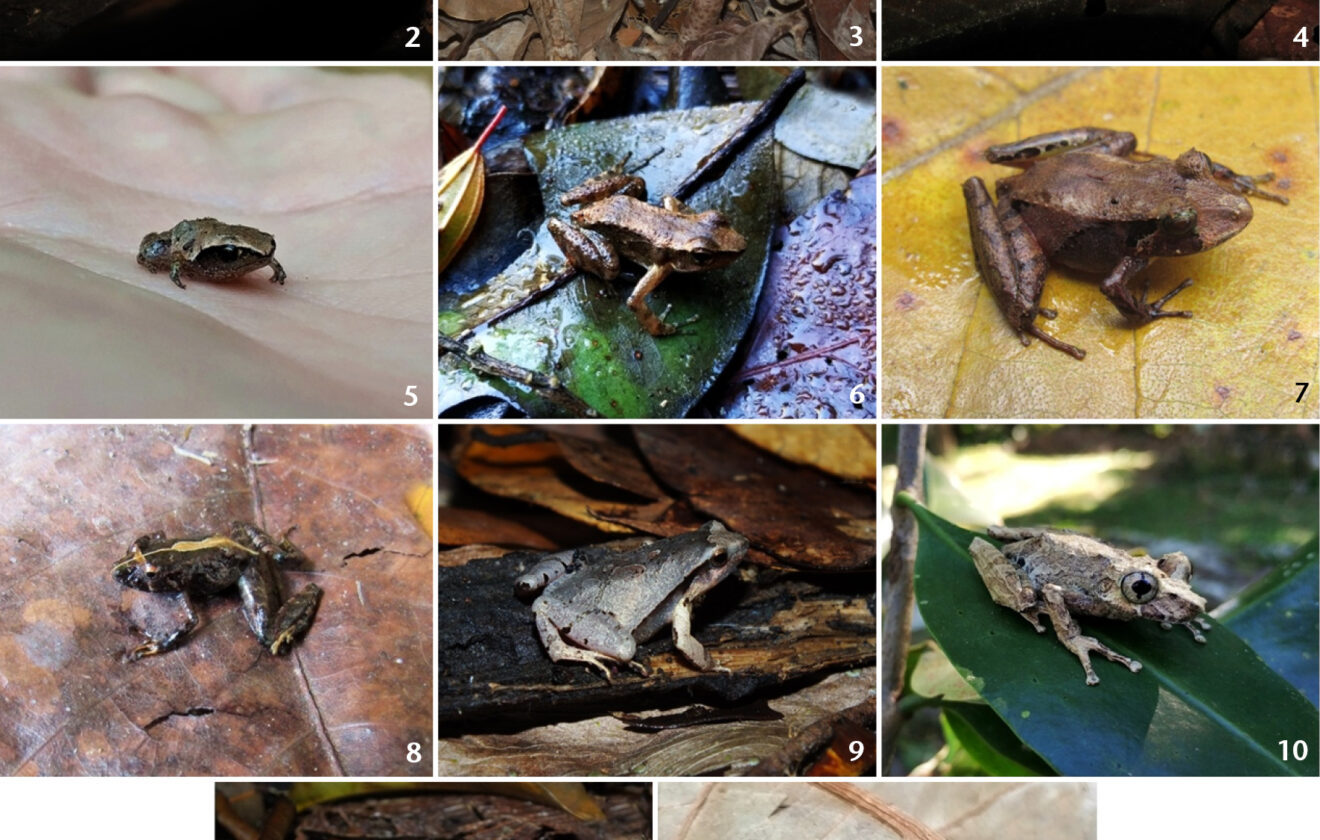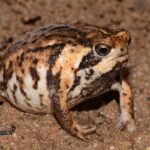Ischnocnema abdita: Uncovering the Hidden Jewel of Brazil’s Atlantic Forest#
Hidden amid layers of lush green foliage, concealed beneath a tapestry of damp, decaying leaves, the small but captivating Ischnocnema abdita lives quietly, a secretive inhabitant of Brazil’s richly biodiverse Atlantic Forest. At first glance, this modest amphibian might go unnoticed, overshadowed by its flashier neighbors. Yet, beneath its humble appearance lies an extraordinary organism, adapted exquisitely to its cryptic lifestyle.
This elusive creature, scientifically known as Ischnocnema abdita, holds special importance not only for scientists who study amphibian diversity and ecology but also for conservation advocates keen on preserving the delicate balance of tropical habitats. Intriguingly, despite their inconspicuous nature, species like Ischnocnema abdita often indicate the health of their ecosystems, acting as quiet alarm bells whispering truths about environmental stability.
Before delving into the specifics that make this frog uniquely adapted to its niche and ecologically invaluable, let us first place it within its larger amphibian family tree.
Taxonomy and Classification#
Ischnocnema abdita belongs to the family Brachycephalidae, a diverse and fascinating lineage of frogs primarily distributed within the tropical regions of South America. Within its genus, Ischnocnema, it shares close evolutionary ties with numerous similarly secretive species known collectively for their terrestrial habits, direct reproductive modes, and specific micro-habitat preferences.
The genus name Ischnocnema originates from the Ancient Greek, “ischno,” meaning slender, and “knema,” meaning shin or leg, referencing their slender limbs and delicate structure. The particular species epithet, “abdita,” derives from the Latin term meaning hidden or concealed – aptly chosen given this frog’s discreet nature and behavior.
Scientists first described Ischnocnema abdita in relatively recent scientific literature, underscoring how much remains unknown even today in the expansive, species-rich habitats of South America. Its classification within this larger group not only helps us understand evolutionary relationships but signals the significance of its place within the ecosystem—or perhaps, as a delicate puzzle piece within a larger mosaic.
Natural Habitat#
Ischnocnema abdita inhabits one of Earth’s biodiversity hotspots: the dense and imposing Atlantic Forest of Brazil. Its range is confined mainly to the southeast, particularly within the state of Rio de Janeiro, where complex mountainous terrain and richly vegetated environments provide the precise conditions these frogs require.
Unlike frogs that lay eggs in streams or ponds, Ischnocnema abdita prefers consistent moisture available on the forest floor, shielded from drying sunlight beneath dense, layered vegetation. It thrives in leaf-litter, bark crevices, beneath fallen logs, or amid tangled tree roots, spots offering both essential humidity and protection from predators.
The thriving leaf-litter micro-habitat creates a protective world in miniature—all the necessary resources at hand, from prey sources such as ants and small arthropods, to hidden refuges that safeguard the frog against larger forest predators. Away from the lush spectacle high in the canopy, the forest floor provides an intricate maze filled with opportunities—and dangers—that shape every aspect of this frog’s ecology.
Physical Characteristics#
Measuring just around 20 to 30 millimeters in length as adults, Ischnocnema abdita is tiny, yet remarkably well-adapted to its microhabitat. Their bodies are squat and compact, delicately structured limbs ideally suited for crawling and hopping silently through dense leaf litter. The skin surface, marked delicately with subtle textures, blends harmoniously with decaying leaf debris—a perfect camouflage against lurking predators, including snakes, spiders, and predatory birds.
The coloration of Ischnocnema abdita typically involves shades of muted browns, grays, or rust-red hues, interspersed with patches and bands of darker pigments. Such cryptic coloration renders them virtually invisible amidst foliage and dirt, a testament to millennia of natural selection shaping their current form.
They bear relatively large eyes—dark and glossy—that protrude slightly above their small heads, necessary adaptations to spotting movement in dense, dimly lit surroundings. Indeed, to see an Ischnocnema abdita in the wild requires both an alert eye and tremendous patience, making encounters exceptional gifts from nature worth savoring.
Behavior and Life Cycle#
The quiet forest floors, seemingly still and calm during daylight hours, become vibrant stages of sound and activity at dusk, when Ischnocnema abdita emerges from sheltered hiding places. They move methodically, hunting a steady stream of small arthropods—mostly ants, spiders, and mites—that populate their micro-habitat.
Unlike many other amphibian counterparts that rely heavily on water bodies, Ischnocnema abdita exhibits a fascinating reproductive strategy known as direct development. Females lay eggs not in water, but moist terrestrial microhabitats under logs or thick leaf litter. Remarkably, these eggs bypass the tadpole stage entirely, hatching directly into tiny, fully-formed miniature frogs. This adaptation allows the frogs to flourish far from pools or water bodies, strictly within the damp, protective niche of their forest floor home.
The male frogs employ soft, repetitive calls during breeding season, gentle choruses punctuating the humid forest air, attracting mates and establishing territorial zones away from conspecific rivals. Breeding and egg-laying events are tied closely to seasonal weather patterns and environmental signals, primarily heavy rainfall and high humidity levels. Once born, young frogs remain sheltered and immobile initially before embarking on their solitary lives within the forest leaf-litter ecosystem.
Ecological Role#
Although small and elusive, Ischnocnema abdita, like many amphibians, occupies a vital position in the ecological pyramid. As insectivores, they help control populations of leaf-litter arthropods, playing a pivotal role in maintaining ecological balance within forest floors. Simultaneously, they serve as prey for larger predators, fulfilling crucial food-chain linkages that support diverse forest biodiversity.
Beyond predator-prey dynamics, amphibians like Ischnocnema abdita are considered crucial bioindicators, responding sensitively to environmental disturbances such as pollution or climatic shifts. Subtle declines in Ischnocnema populations are often early indicators of deeper ecological disturbances affecting the entire forest ecosystem, clues for conservationists to investigate underlying issues swiftly.
Threats and Conservation Status#
Ischnocnema abdita faces significant threats from ongoing deforestation, fragmentation, and habitat alteration across Brazil’s Atlantic Forest. Urbanization, agricultural expansion, logging, and mining activities encroach progressively on pristine habitats, shrinking available safe havens essential to the species’ survival and reproductive success.
Additionally, climate shifts present particularly delicate risks for species heavily dependent upon specific moisture and temperature regimes. Amphibians globally face increasing susceptibility to diseases such as chytridiomycosis, and introducing exotic pathogens further complicates conservation strategies.
Currently, data deficiency hinders comprehensive conservation measures for Ischnocnema abdita. Scientists continually urge ongoing monitoring and extensive surveys to properly assess their population statuses accurately and inform targeted habitat protection measures.
Cultural and Scientific Significance#
While not widely known in cultural folklore, amphibians like Ischnocnema abdita increasingly represent symbols of environmental conservation campaigns that emphasize biodiversity and healthy forest ecosystems in Brazil. They stir curiosity among scientific communities, revealing insights about amphibian evolution, adaptation mechanisms, and ecological interactions within tropical forests.
Conclusion: Protecting Hidden Bio-Gems of the Forest#
The story of Ischnocnema abdita highlights just how profoundly biodiversity depends upon intricate ecological connections, underlining the importance of preserving vast yet fragile habitats such as Brazil’s Atlantic Forest. Each hidden frog carries secrets and wisdom about evolutionary adaptation and ecological integrity, silently supporting countless other species.
Protecting such species requires collective awareness and dedicated advocacy—reminding us constantly of our intimate connection with the natural world. To safeguard these extraordinary, secret beings, and the forests that sustain them, is to actively protect the vitality and richness of our planet for generations to come.









